

Watch a world of fall color go by on the Blue Ridge Parkway © Pierre Leclerc Photography / Getty Blue Ridge Parkway, North Carolina and Virginia See Vermont's vivid fall landscapes best with these road trips Generally, foliage colors peak in the last week of September and the first half of October. Stowe has a long window for leaf peeping, which can start as early as the first week of September and run through mid-October. When to go in 2022: Fall-color ogling in Vermont is such a seasonal tourism draw that multiple services, such as Stowe's Foliage Finder ranking, track peak foliage locations through autumn. Stowe, the unofficial – but totally justified – capital of fall color, is the perfect base camp for leafy adventures, connected to hundreds of miles of hiking and cycling trails, and boasting easy access to the highest points of Vermont's Green Mountains. Much of the credit can go to the sugar maple, native to the northeast and adjacent parts of Canada, but a host of other trees including oaks, alders and basswoods add daubs of yellows and oranges to the palette.

If you visit at the right time, the vast sweeps of reds and golds are unmatched.

New England is synonymous with fall colors in the US, and for good reason. NASA.Fall colors surround the Stowe Community Church in Vermont © DonLand / Shutterstock Stowe, Vermont.Marshall Space Flight Center Meteoroid Environment Office.Search this blog Search for: Search Archives Today, we celebrate the equinox as an astronomical event caused by Earth’s tilt on its axis and its motion in orbit around the Sun.Įnjoy the new season – whichever side of the globe you’re on! Additionally, earlier civilizations built the first observatories, like Stonehenge in Wiltshire, England, and the Intihuatana stone in Machu Picchu, Peru, to follow the Sun’s annual progress. They knew that the Sun’s path across the sky, length of daylight, and location of sunrise and sunset all shifted in a regular way throughout the year.

The people of ancient cultures used the sky as a clock and calendar. We will also feel cooler days with chillier winds, and dry, falling leaves. In the Northern hemisphere, the September equinox marks the start of a period bringing us later sunrises and earlier sunsets. But on these special days – the spring and fall equinoxes – the Sun shines almost equally on the Northern and Southern hemispheres. That’s because Earth’s axis is tilted with respect to the Sun-Earth plane. The rest of the year, the Sun shines unevenly over the Northern and Southern Hemispheres. This only happens twice in Earth’s year-long trip around the Sun. Spring twilight at the North Pole begins a few weeks before the vernal, or spring, equinox in March, when the Sun rises above the horizon again. Credit: NASA/JPL-CaltechĪlong with marking the beginning of astronomical fall, the Sun will be exactly above Earth’s equator, moving from north to south, making day and night nearly equal in length – about 12 hours – throughout the world.Īt the North Pole, over the upcoming days, the Sun will sink below the horizon for a kind of twilight from now until sometime in October when it will be completely dark, according to NASA solar scientist Mitzi Adams. During the equinoxes, both hemispheres receive equal amounts of daylight. An illustration of the March (spring) and September (fall or autumn) equinoxes. 1, however, the September (or fall) equinox gives us the green light to welcome the astronomical fall season in the Northern Hemisphere (and astronomical spring season in the Southern Hemisphere). In meteorology, the fall season begins on Sept.


 0 kommentar(er)
0 kommentar(er)
